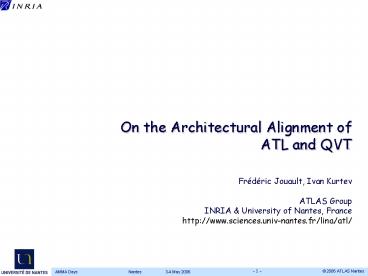Model transformation with ATL PowerPoint PPT Presentation
1 / 16
Title: Model transformation with ATL
1
On the Architectural Alignment of ATL and
QVT Frédéric Jouault, Ivan Kurtev ATLAS
Group INRIA University of Nantes,
France http//www.sciences.univ-nantes.fr/lina/atl
/
2
Outline
- Need for ATL and QVT alignment
- QVT architecture
- ATL architecture
- Alignment of architectural components
- Achieving interoperability between ATL and QVT
- Conclusion
3
A DSL Perspective on MDE
- MDE allows definition of small (and large!)
languages, focused on specific problems known as
Domain Specific Languages (DSLs) - Typical tasks in MDE also require DSLs for
example, model transformations and language
definition - A set of transformation languages exists
4
Problems
- Language fragmentation (Babylon tower)
- Need for managing DSLs
- Multiple languages per problem domain
- Problem domains often overlap
- Need for choosing among DSLs
- Need for clear guidelines and knowledge for
- Matching the problem domain and the available
solutions (DSLs) - Explicit comparison among languages to allow
selection of the right tool
5
Aligning ATL and QVT
- Two model transformation languages for MDE
- Solving the same problem (at first glance)
- Is that true?
- Comparing ATL and QVT
- At architectural level (components and major
capabilities) this work! - At problem domain level (what problems can be
solved, what are the requirements per language)
future work
6
Architectural Alignment of ATL and QVT
- Architecture set of concepts and relations
- Alignment for the major components of ATL and
QVT - Major goal
- Achieving interoperability between ATL and QVT
7
QVT Architecture
- Contains three DSLs that form layers
- Relations (declarative)
- Core (declarative, simpler than Relations)
- Operational Mappings (imperative)
8
Conformance Points for QVT Tools
Note that QVT conformance is defined for tools.
The term QVT compliant language is not defined
in the spec.
9
ATL Architecture
Three-level architecture
10
ATL Components
- AMW (ATLAS Model Weaver) Generic metamodel for
establishing links among model elements
(metamodel for model weaving) - Tool for defining domain specific transformation
languages - ATL hybrid transformation language
- Semantics of AMW extensions may be defined by ATL
transformations - ATL VM virtual machine for executing model
transformations
11
ATL and QVT Component Alignment (1)
Abstractness
12
ATL and QVT Alignment (2)
Abstractness
13
ATL and QVT Interoperability (1)
- Interoperability executing programs written in
one language with the tools designed for another
language.
- Motivations
- Problem-Language adequacy
- Execution and support tools
- Assume you have a wonderful language without
engine and a not so nice language with execution
engine - Compliance to standards
- If QVT programs run on the ATL VM then the ATL VM
is QVT conformant!
14
ATL and QVT Interoperability (2)
- Framework for reasoning about interoperability
among ATL and QVT components
15
ATL and QVT Interoperability (3)
16
Conclusions
- Architectural alignment between ATL and QVT shows
that language interoperability is possible via
model transformations - ATL tools may be called QVT conformant after the
required transformations are provided - It is interesting to generalize the framework for
reasoning on ATL and QVT to other languages

